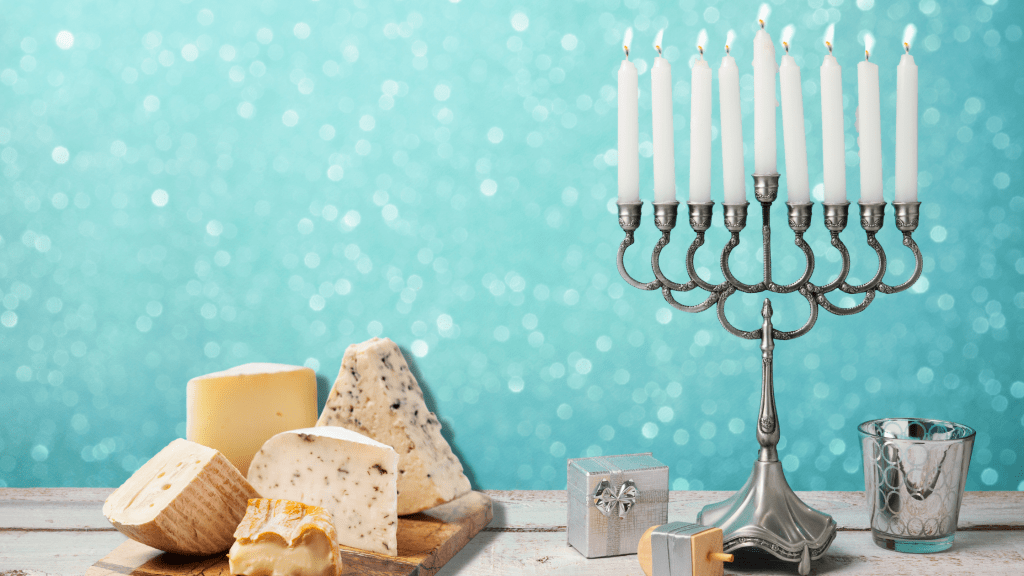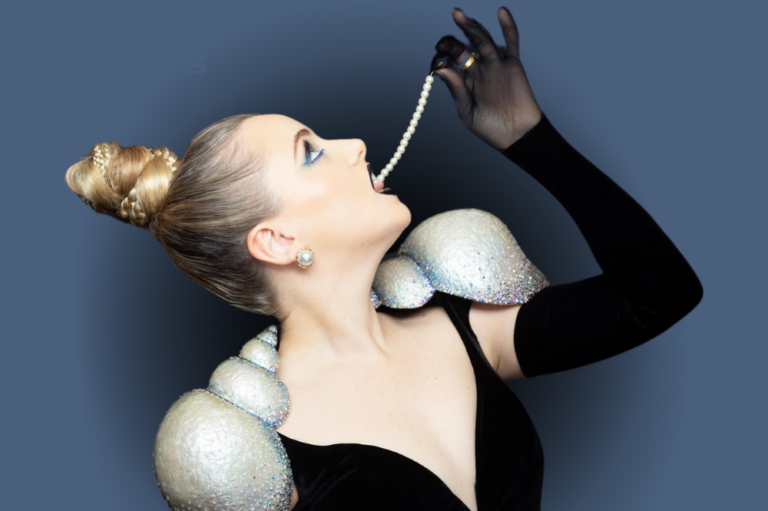Adapted from an original blog published in The Times of Israel
Whether it’s latkes, sufganiyot, keftes (fried vegetable patties), or sfenj (North African doughnuts), Jews from all backgrounds can come together around a central culinary trend for Hanukkah: deep-fried foods, full of oil aplenty, to honor the Hanukkah miracle of the Temple’s long-burning oil. It may come as a surprise to many, then, that a different Hanukkah menu is recorded in the most central code of Jewish law.
The Shulhan Arukh states: “Some say that cheese should be eaten on Hanukkah, because the miracle was done with milk, which Judith fed to the enemy” (Orah Hayim 670:2, gloss of the Rema). Which miracle? Who was Judith? Why did she feed her enemy cheese, and what does this have to do with our Hanukkah celebration? Finally, what does it mean to engage with a tradition of holiday dairy consumption in an economy in which almost all dairy available comes from violent factory farm conditions that would have been unimaginable to the codifiers of those traditions?
The Book of Judith is an ancient work of political historical fiction that appears in the Septuagint, the earliest extant Greek translation of the Hebrew Bible, but has never been included in any Jewish canon of the Bible. Likely authored by a pro-Hasmonean Jew, probably in Greek, the book tells the story of a heroine brazenly assassinating the oppressor, General Holofernes, to turn the tides of war. Though the original book is not connected explicitly to Hanukkah or the Maccabees, the story becomes connected to Hanukkah when it shows up in medieval Jewish folklore and rabbinic discourse in both Sephardic and Ashkenazic communities. In all these versions, when General Holofernes besieges the Jewish capital, a beautiful, sharp-witted, bold widow named Judith convinces him that she will help deliver the Jews to him, then gets him drunk until he passes out, takes his sword, and cuts off his head. The Jews, emboldened by the sight of their oppressor’s severed head, go on the offensive and vanquish their enemy.
The 14th century’s Ashkenazic compendium Kol Bo (44:9), which was likely the main source for the statement in the Shulhan Arukh, records it this way:
“Women are obligated to light Hanukkah candles, for they too were included in the miracle. This means that the enemies came to destroy everyone, men, women, and children, and there are those who say that the great miracle occurred through a woman. Her name was Judith, as the story goes, and she was the daughter of Yochanan, the high priest. She was extremely beautiful, and the Greek king wanted her to lay with him. She fed him a dish of cheese to make him thirsty, so that he would drink a great deal and became drunk, and recline and fall asleep. And it happened just that way, and once he was asleep, she took his sword and cut off his head. She brought his head to Jerusalem, and when the armies saw that their leader had been killed, they fled. For this reason, we have the custom of eating a cheese dish on Hanukkah.“
Before we drop everything to whip up fun, “traditional,” Hanukkah quiche and cheese spreads, let’s make sure that we avoid cherry-picking. Let’s consider this custom in context of its full meaning. While oily foods in popular contemporary Hanukkah folklore celebrate the abundance of oil with which God miraculously rewarded the faithful for their religious devotion, dairy food in the medieval custom reflected the tool used to lure a person to sleep for the sake of committing righteous violence against him. In this way, the medieval versions of the Judith story recognize the echoes of the biblical Yael luring General Sisera to sleep and smashing a peg through his skull (Judges 4:18-21). Just as Yael’s tool for coaxing him to sleep was milk, in the medieval story Judith uses cheese to lure her enemy to sleep so she can kill him.
This nexus of sleep, violence, and dairy food is heightened in another medieval version of the Judith story, found in the 14th century Megilat Yehudit. This version aligns Hanukkah and its celebrations with Purim and its feast, using language taken directly from the Book of Esther to tell Judith’s story. In this telling, Hanukkah, too, is a day of “sending portions to one another” (Esther 9:22). Like our Purim feasts, the Hanukkah celebration should mimic the wicked buffoon King Ahasuerus’s feast, in which “the drinking was according to the law: none did compel” (Esther 1:8).
This medieval Hanukkah is not just a festival of oil burning long once the messy war stuff is over; it is the kind of “feasting and joy and good day” (Esther 9:19) marked by celebrating violently slaughtering those who would have done us worse. The revelry suggests that brutality and caprice are the ways of the world, and perhaps that villain and hero are hard to distinguish. On Purim, “a person is obligated to become intoxicated to the point of not knowing the difference between cursed Haman and blessed Mordekhai” (Talmud Bavli, Megillah 7b). In the Megilat Yehudit Hanukkah tradition, we engage in similar revelry: the text calls Judith a queen and describes her presiding over the feast with the same language used in the Bible to describe Ahasuerus’s festive conduct: “Queen Judith had appointed to all the officers of [his] house, that they should do according to every man’s pleasure” (mimicking Esther 1:8).
For Hanukkah, cheese functions like alcohol on Purim: meaningful in its brutally honest embrace of the violence of the world, in its recognition that oppressors have lured us to sleep in order to abuse us, and in its contrast to sober, controlled, ordinary behavior. In a world without systemic justice, but with our soporific wine and cheese, we will fantasize about luring the oppressors to sleep so that we can destroy them.
And that’s just it: this symbolism has greater dystopian meaning today than ever before. In historically unprecedented ways, dairy today does come to us via brutal violence. We, as the consuming public, have been lured to sleep, inattentive to the brutality carried out by those committed to our not recognizing their violence. Typical dairy advertising either erases the scenes of production or masks them with pastoral images of grazing cows that would be unrecognizable to any actual cow or human worker in the dairy system behind those products. Dairy from factory farms is almost all of the dairy on the market. Dairy cows often suffer worse abuses than cattle raised for beef (who, at least, spend a portion of their lives grazing on pasture): in dangerously close quarters, they are sick from inappropriate feed and forcibly impregnated for multiple cycles before being sent to slaughter. Even if we abstain from veal because of the notorious cruelty involved in raising of veal calves, we support veal production when we consume dairy, as dairy cows bear male calves who are slaughtered for veal after 16-18 weeks of life.
Today’s dairy industry also practices violence on our planet and all who inhabit it. In light of recent reports on climate change and the massive known contributions of emissions from animal agriculture, one of the key ways we can mitigate the existential threat to humans is by replacing dairy with plant-based alternatives.
Despite misleading efforts to appeal to consumers conscious of animal welfare and planetary health, no dairy available on the market is free of significant harms. And unless you have a direct relationship with your family farmer, buying dairy products only contributes to an industry where corporate agriculture is increasingly taking control of all stages of production.
Telling the story of Judith’s mythic use of cheese as an instrument of war can remind us of the violence always latent in the acquisition and consumption of animal products. For Judith, it was controlled; in our economy, it’s rampant. Those drawn to practice this medieval Jewish custom can challenge themselves to let their Hanukkah cheese eating resemble Purim alcohol drinking: a practice of appetitive excess meaningful precisely because it stands in contrast to the sober and responsible guidelines that frame our eating the rest of the year. People who experience near annihilation, who survive by annihilating others, may understandably consume without regard for consequence. That experience is dramatized on Purim and in the medieval version of Hanukkah. When people consume that way every day, the planet crumbles toward collapse, becoming dystopian and violent world we inhabit, the world governed by factory farms.
Whether or not one eats cheese ceremonially for Hanukkah, we must dismantle the Antiochius-like brutality of the industrial agricultural industry. Through communal policies that divest support from factory farming, we weaken Antiochus-like violent oppressors while building ethical and sustainable Jewish American communities in the process. So this Hanukkah, next Hanukkah, and year-round—take a step toward liberation through food.




